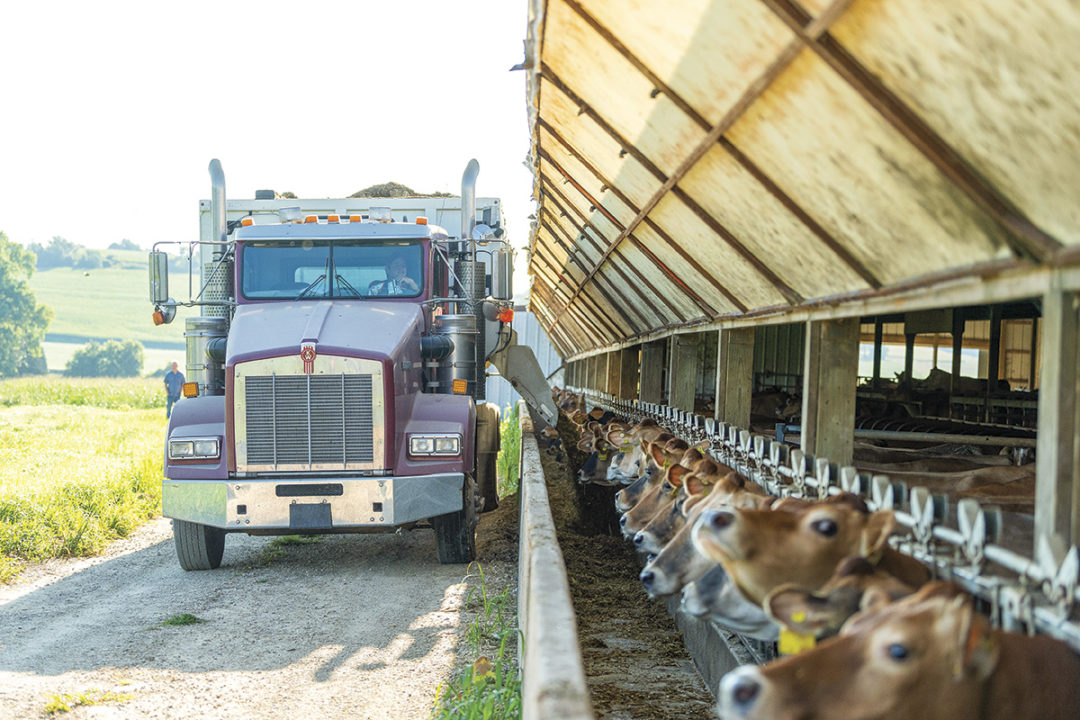Since its detection in 47 states, highly pathogenic avian influenza has become the largest foreign animal disease (FAD) outbreak in U.S. history, affecting more than 58 million birds and hundreds of producers. Observing the effects of disease outbreaks in other animal agriculture industries creates an opportunity for dairy producers to look more closely at their biosecurity practices and ask, “Is my dairy prepared for a FAD threat?”
Biosecurity, the measures taken to prevent the spread of disease-causing organisms, can be challenging for a busy producer. With the emergence of SARS-CoV-2 (COVID-19), the shape of these discussions has changed in recent years, and we will likely see increased public attention to biosecurity practices and animal health. We all know that healthy cows are more profitable, yet our herds are more connected than ever before. Producers can make the most of their time spent on biosecurity by understanding how pathogens are transmitted, then focusing prevention efforts where they will have the greatest impact.
Pathogens, disease-causing organisms such as bacteria or viruses, can infect an animal via many routes, including inhalation of aerosolized droplets through the nose and ingestion where pathogens enter the body along with feed or water. Areas where mucus membranes may be exposed – the eyes, vulva or teat ends – are also vulnerable to infection. Animals can contract disease through breaks in the skin, like a wound or insect bite, and through an injection if aseptic technique is not utilized. Bodily fluids, including urine, feces and milk from an infected animal, can spread pathogens to others in their environment.
Practices on a dairy can either protect these entry points or leave them vulnerable to foot rot, mastitis and respiratory infections. When we move animals, whether bringing in new animals or mixing groups, we increase the risk of spreading pathogens. Manure, waste and bedding can also transmit disease either through direct contact with susceptible animals or through fomites (objects that can transmit disease).
For example, milk trucks, feed trucks and other vehicles can transmit pathogens. One study showed that the average dairy reported 484 vehicle visits per year. Each of these visits present an opportunity to control traffic flow and the potential spread of pathogens. Tires can pick up or drop manure, as can the boots of vehicle operators. Thinking about ways to keep vehicles away from vulnerable populations, such as utilizing separate driveways, can reduce risk.
The good news is that the same measures that protect our dairy herds from common diseases can limit the exposure to, or spread of, reportable diseases and FADs. When we consider FADs, such as bovine spongiform encephalopathy (BSE) – also known as “mad cow” disease, vesicular stomatitis and foot and mouth disease (FMD), these diseases are transmitted via those same routes just like many common illnesses. Good biosecurity practices can help protect your farm and animals today and in the future.
If we could place a bubble over your dairy and prevent the movement of people and animals on and off the property, the risk of introduction of a novel pathogen would be almost non-existent. As producers and veterinarians, we need to think about ways to create our own barrier while maintaining continuity of business so dairy farms can continue to do what they do best.
This barrier starts with the requirements for animals and animal products imported to the U.S. through international ports. Preventing the transmission of FADs, or the spread of infectious and contagious disease, is a major reason for the strict import requirements for animals and animal products. These requirements are the first line of defense between U.S. herds and novel pathogens.
The next barrier is your state’s entry requirements. These vary considerably by state, species and the purpose of the move. Requirements are usually based on risk and are often different for movement to slaughter as compared to movement of breeding. Common requirements include official ID and premises identification for traceability, as well as a certificate of veterinary inspection showing that the origin herd was evaluated and did not show evidence of contagious disease. Some situations may require an import permit, results of pre-movement testing or proof of vaccination.
Whether you purchase replacement animals at a market or work with a heifer raiser, most modern dairies are not considered a closed herd. How much information do you have about the biosecurity practices of the farm from which your animals originated? Once replacement animals arrive on your operation, are they isolated from your milking herd or most vulnerable populations? Do you require any testing prior to introduction? Knowing the health status of your source herds can help to prevent entry of pathogens.
The barrier to disease transmission that producers can control is their farm-specific biosecurity plan. A well-constructed plan will limit pathogen introduction, as well as potential spread of disease between animal groups or off the property. The steps you take to maintain the health and well-being of your herd through good nutrition and husbandry practices are your last line of defense, should a pathogen enter your farm. When thinking about the most vulnerable groups of animals you work with, such as calves and fresh cows, are there ways to further isolate them from disease threats? Healthier animals resist disease incursion, which leads to better animal production and, ultimately, greater economic benefits.
Our modern agriculture systems are designed to be efficient. Unfortunately, some of these efficiencies create opportunities for pathogen introduction and transmission. Although we cannot raise our dairy herds in a bubble, a strong biosecurity plan can protect your herd. Just as no two farms are the same, the plan you develop for your operation should be designed to address the specific risks on your farm. These plans are important to protect not only your farm, but the entire U.S. food supply. In the event of a disease outbreak, your biosecurity plan is one of the first things your veterinarian and state animal health officials will need. Movement creates risk, in any species. Consider what you allow into your bubble and what steps you will take before or after people, animals or vehicles cross that line in order to maintain the health and well-being of your herd.
There are many resources available to producers to assess your operation’s risks and create or update a biosecurity plan. If you practice biosecurity but do not have a written plan, start by completing a risk assessment to determine areas for improvement. If your plan is outdated, maybe this is an opportunity to identify where things have changed. Then, make an appointment with your veterinarian to review the plan. If you already have a well-managed plan in place, consider reviewing how employees are trained on its procedures, or start a conversation about worst-case scenarios and how the plan would change during an outbreak. Farm-level biosecurity and working closely with your herd veterinarian remain the best thing you can do to protect your farm – and your business – against common illnesses and FADs.
References omitted but are available upon request. Click here to email an editor.










